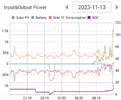- Joined
- 27 Jan 2008
- Messages
- 23,668
- Reaction score
- 2,667
- Location
- Llanfair Caereinion, Nr Welshpool
- Country

Theory the battery should not discharge any more once it hits 10% where there is grid power and 3% when grid power is lost, this means I will always have some power to run the central heating if grid power is lost, and should prevent battery damage due to over discharge. This is what I expect to see, the purple line state of charge being flat as it drops to 10%

However most days I see this, where the state of charge drops to zero for a short time.

And often does not return to 10% for quite some time, so the back up which should be there is gone. And already had one battery fail. This was replaced FOC and the firm which installed the system do seem to be trying to resolve the problem. However is this problem just with my system, or is it wide spread, the chart is from the PC, the phone app does show it, but harder to find and see what is going on, so may be people are simply not aware it is going on? One can't hover a mouse pointer over the chart on a phone to show the window seen on PC version giving the data.
but harder to find and see what is going on, so may be people are simply not aware it is going on? One can't hover a mouse pointer over the chart on a phone to show the window seen on PC version giving the data.
Also it should not be charging a battery when also importing from the grid, as the day goes on and the usage increases, and the solar increases the scale will change to accommodate the higher figures, so again harder to see what has happened.
But is this normal and most don't notice what is going on, or have I got a rouge system?
However most days I see this, where the state of charge drops to zero for a short time.
And often does not return to 10% for quite some time, so the back up which should be there is gone. And already had one battery fail. This was replaced FOC and the firm which installed the system do seem to be trying to resolve the problem. However is this problem just with my system, or is it wide spread, the chart is from the PC, the phone app does show it,
 but harder to find and see what is going on, so may be people are simply not aware it is going on? One can't hover a mouse pointer over the chart on a phone to show the window seen on PC version giving the data.
but harder to find and see what is going on, so may be people are simply not aware it is going on? One can't hover a mouse pointer over the chart on a phone to show the window seen on PC version giving the data.Also it should not be charging a battery when also importing from the grid, as the day goes on and the usage increases, and the solar increases the scale will change to accommodate the higher figures, so again harder to see what has happened.
But is this normal and most don't notice what is going on, or have I got a rouge system?

